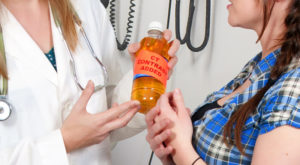
Medical imaging allows your child’s physician to see inside their body, making it much easier to diagnose and treat injuries and illnesses. These procedures, such as X-rays, computed tomography (CT), nuclear medicine, magnetic resonance imaging (MRI), and ultrasound, create images of your child’s organs without the need for surgery.
To improve these pictures, your child’s physician may use contrast materials (also called contrast agents or contrast media) during their procedure. These materials help distinguish — or contrast — certain parts of their body, such as organs or blood vessels, from surrounding tissue.
What Happens During Medical Imaging With Contrast?
Contrast materials can be injected into a blood vessel using an intravenous line (IV) or swallowed. In both cases, it’s given either before or during your child’s medical imaging procedure.
If your child is getting contrast injected into a blood vessel, a radiology nurse will insert an IV into their hand or arm. The nurse will place the IV in a procedure room, where there is a double chair that allows extra room for you to sit next to them. Once you and your child are in a comfortable position, the RN will begin the IV placement process. Your child may feel a slight prick where the IV is inserted.
During their procedure, their IV will be connected to a machine that controls how much contrast goes into their body, or it will be given by hand by the radiology tech. The radiology tech will take the IV out when they are finished with the procedure.
Some medical imaging procedures may also be scheduled with contrast for your child to drink, and there are some flavor choices are available for them to choose from.
What Happens After My Child Has Received Contrast Dye?
Contrast materials don’t permanently dye your child’s organs, and they will be absorbed by their body or eliminated through urine or bowel movements.
However, to help your child’s body get rid of the contrast, it’s important to give them extra fluids on the day they received contrast.
Reactions to contrast are rare, but radiologists are well-equipped to handle them if they do occur. If your child experiences a reaction, they may be given medicine to treat their symptoms. If their reaction gets worse within the next day, you can give your child over-the-counter diphenhydramine (Benadryl) as instructed on the package. This medicine may make your child sleepy.
Some reactions may be delayed, so it’s important to watch your child for symptoms for 48 hours after their procedure:
- Hives or other skin rashes
- Wheezing
- Itching
- Nausea or vomiting
- Difficulty swallowing
If your child develops any of these symptoms, please notify their primary care physician. Have them notify the Children’s Nebraska’s Radiology department so their reaction can be noted in your child’s medical record. You should also be sure to inform any physician that will be ordering an examination that may need contrast.
If your child develops difficulty breathing or swallowing, call 9-1-1 immediately.
Oral Contrast
Your child may receive an oral contrast, such as NeuLumEX, which is a diluted barium solution flavored with sugar. Because their body Can’t absorb this type of contrast, it will cause soft or liquid stools about 2 to 3 hours after taking it.
This is not diarrhea, and stools should return to normal once the oral contrast passes. Some children are sensitive to the sugar in the oral contrast, which may cause more prolonged loose stools.
What Happens If Contrast Leaks Outside The Vein?
Occasionally, contrast that has been inserted into the vein can leak into the fatty tissue surrounding the vein. This is called contrast extravasation, and it may cause some swelling and bruising accompanied by mild discomfort.
If this happens, your child’s IV site will be elevated above the level of their heart while they are still in the radiology department. They will also need to apply cold compresses to the site for 15 to 20 minutes per hour.
Once a nurse or physician has evaluated your child and you leave the radiology department, you will need to continue applying ice to the affected area for 15 to 20 minutes every 4 hours. Keep applying ice for the next 24 to 72 hours while your child is awake. This will decrease the swelling and minimize discomfort. Do not apply ice directly to the skin. Keep the ice pack wrapped in a dish towel so it doesn’t burn your child’s skin. You can also apply warm compresses to the site after 24 hours.
Rarely, the extravasation is in an area that may put pressure on your child’s veins or nerves in their arms or hands. If you notice any of the following symptoms, call your child’s physician right away and follow their instructions:
- Swelling
- Numbness
- Blistering of the skin
- Increased pain
If you Can’t reach your child’s physician, take them to the emergency room, and bring their paperwork with you. Be sure to also inform your child’s primary care physician of their contrast extravasation so it can be noted in their medical paperwork.
Do you have more questions related to contrast dye during an imaging test? Contact the Radiology Child Life Specialist at 402-955-4042 or the Radiology Department at 402-955-5602.
What To Do Next
For Patients
Your child will need an order from a provider to schedule a radiology procedure. Once the order is placed, call 402-955-6799 to schedule the procedure.
For Referring Providers
The Physicians’ Priority Line is your 24-hour link to pediatric specialists at Children’s for referrals, emergency and urgent consults, physician-to-physician consults, admissions, and transport services. Call 855-850-KIDS (5437).
Learn more about referring patients.